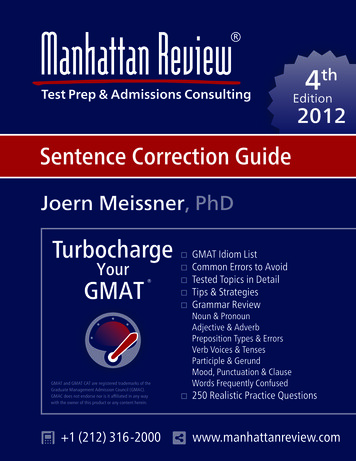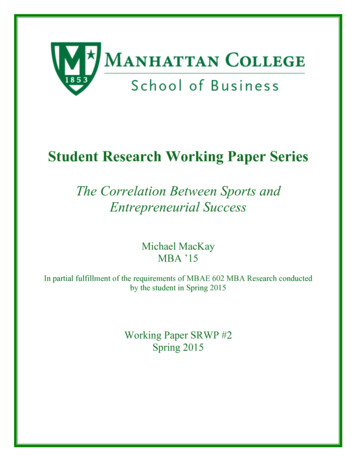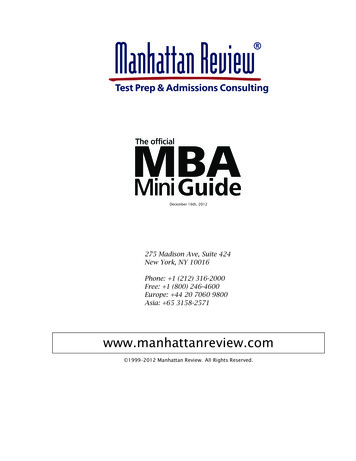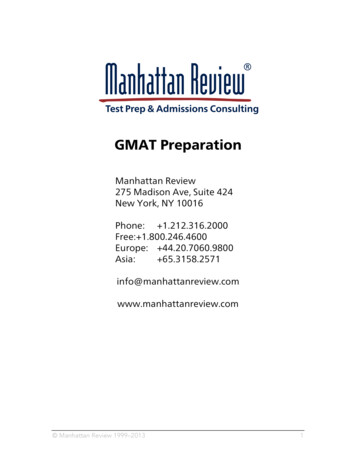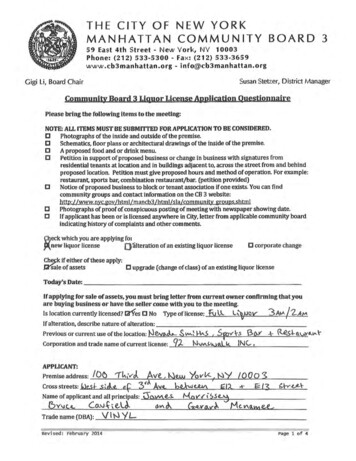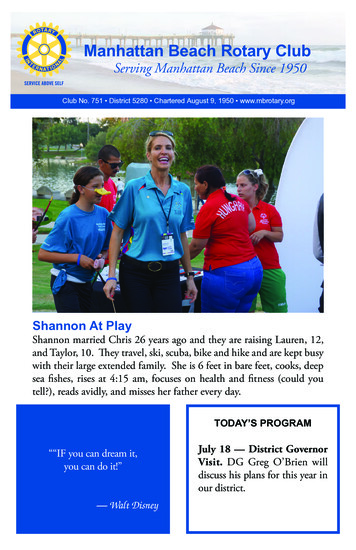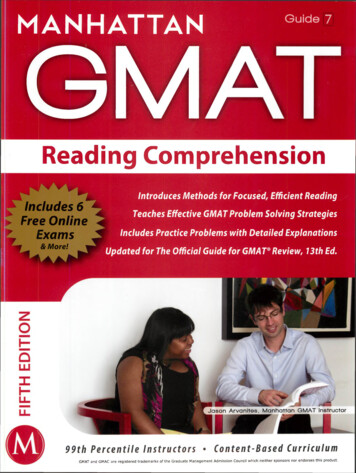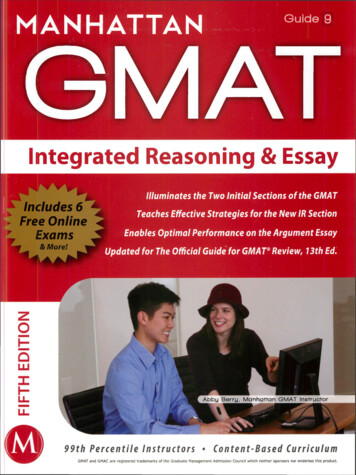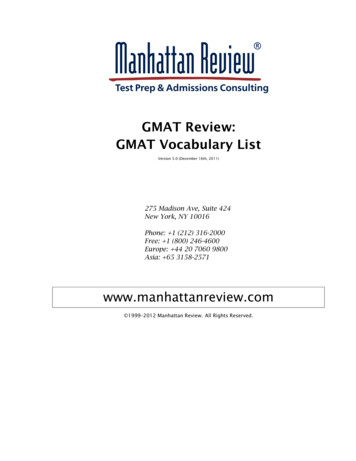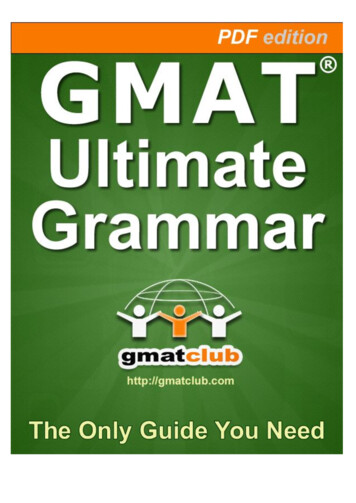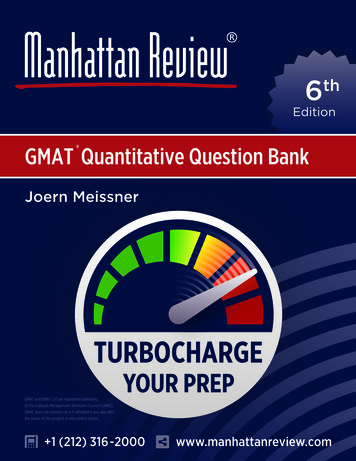
Transcription
6thEditionGMAT Quantitative Question Bank Joern MeissnerTURBOCHARGEGMAT and GMAT CAT are registered trademarksof the Graduate Management Admission Council (GMAC).GMAC does not endorse nor is it affiliated in any way withthe owner of this product or any content herein.YOUR PREP 1 (212) 316-2000www.manhattanreview.com
Turbocharge your GMAT:Quantitative Question Bankpart of the 6th Edition SeriesApril 20th, 2016 Complete & Challenging Training Set Problem Solving - 250 Questions Data Sufficiency - 250 Questions Questions mapped according to the scope ofthe GMAT Over 100 questions with Alternate Approaches Text-cum-graphic explanationswww.manhattanreview.com 1999–2016 Manhattan Review. All Rights Reserved.
iiQuantitative Question BankCopyright and Terms of UseCopyright and TrademarkAll materials herein (including names, terms, trademarks, designs, images, and graphics) are the property of Manhattan Review, except where otherwise noted. Except as permitted herein, no such materialmay be copied, reproduced, displayed or transmitted or otherwise used without the prior writtenpermission of Manhattan Review. You are permitted to use material herein for your personal, noncommercial use, provided that you do not combine such material into a combination, collection, orcompilation of material. If you have any questions regarding the use of the material, please contactManhattan Review at info@manhattanreview.com.This material may make reference to countries and persons. The use of such references is for hypothetical and demonstrative purposes only.Terms of UseBy using this material, you acknowledge and agree to the terms of use contained herein.No WarrantiesThis material is provided without warranty, either express or implied, including the implied warrantiesof merchantability, of fitness for a particular purpose and noninfringement. Manhattan Review doesnot warrant or make any representations regarding the use, accuracy or results of the use of thismaterial. This material may make reference to other source materials. Manhattan Review is not responsible in any respect for the content of such other source materials, and disclaims all warrantiesand liabilities with respect to the other source materials.Limitation on LiabilityManhattan Review shall not be responsible under any circumstances for any direct, indirect, special,punitive, or consequential damages (“Damages”) that may arise from the use of this material. In addition, Manhattan Review does not guarantee the accuracy or completeness of its course materials,which are provided “as is” with no warranty, express or implied. Manhattan Review assumes no liability for any Damages from errors or omissions in the material, whether arising in contract, tort orotherwise.GMAT is a registered trademark of the Graduate Management Admission Council.GMAC does not endorse, nor is it affiliated in any way with, the owner of this product or any contentherein.10-Digit International Standard Book Number: (ISBN: 1-62926-066-5)13-Digit International Standard Book Number: (ISBN: 978-1-62926-066-2)Last updated on April 20th, 2016.Manhattan Review, 275 Madison Avenue, Suite 1429, New York, NY 10016.Phone: 1 (212) 316-2000. E-Mail: info@manhattanreview.com. Web: www.manhattanreview.comwww.manhattanreview.com 1999–2016 Manhattan Review
Quantitative Question BankiiiAbout the Turbocharge your GMAT SeriesThe Turbocharge Your GMAT Series is carefully designed to be clear, comprehensive, and contentdriven. Long regarded as the gold standard in GMAT prep worldwide, Manhattan Review’s GMAT prepbooks offer professional GMAT instruction for dramatic score improvement. Now in its updated 6thedition, the full series is designed to provide GMAT test-takers with complete guidance for highly successful outcomes. As many students have discovered, Manhattan Review’s GMAT books break downthe different test sections in a coherent, concise, and accessible manner. We delve deeply into thecontent of every single testing area and zero in on exactly what you need to know to raise your score.The full series is comprised of 16 guides that cover concepts in mathematics and grammar from themost basic through the most advanced levels, making them a great study resource for all stages ofGMAT preparation. Students who work through all of our books benefit from a substantial boost totheir GMAT knowledge and develop a thorough and strategic approach to taking the GMAT. ATGMATGMATGMATMath Essentials (ISBN: 978-1-62926-057-0)Number Properties Guide (ISBN: 978-1-62926-058-7)Arithmetics Guide (ISBN: 978-1-62926-059-4)Algebra Guide (ISBN: 978-1-62926-060-0)Geometry Guide (ISBN: 978-1-62926-061-7)Word Problems Guide (ISBN: 978-1-62926-062-4)Sets & Statistics Guide (ISBN: 978-1-62926-063-1)Combinatorics & Probability Guide (ISBN: 978-1-62926-064-8)Data Sufficiency Guide (ISBN: 978-1-62926-065-5)Quantitative Question Bank (ISBN: 978-1-62926-066-2)Sentence Correction Guide (ISBN: 978-1-62926-067-9)Critical Reasoning Guide (ISBN: 978-1-62926-068-6)Reading Comprehension Guide (ISBN: 978-1-62926-069-3)Integrated Reasoning Guide (ISBN: 978-1-62926-070-9)Analytical Writing Guide (ISBN: 978-1-62926-071-6)Vocabulary Builder (ISBN: 978-1-62926-072-3) 1999–2016 Manhattan Reviewwww.manhattanreview.com
ivQuantitative Question BankAbout the CompanyManhattan Review’s origin can be traced directly back to an Ivy League MBA classroom in 1999. Whileteaching advanced quantitative subjects to MBAs at Columbia Business School in New York City, Professor Dr. Joern Meissner developed a reputation for explaining complicated concepts in an understandable way. Remembering their own less-than-optimal experiences preparing for the GMAT, Prof.Meissner’s students challenged him to assist their friends, who were frustrated with conventionalGMAT preparation options. In response, Prof. Meissner created original lectures that focused onpresenting GMAT content in a simplified and intelligible manner, a method vastly different from thevoluminous memorization and so-called tricks commonly offered by others. The new approach immediately proved highly popular with GMAT students, inspiring the birth of Manhattan Review.Since its founding, Manhattan Review has grown into a multi-national educational services firm, focusing on GMAT preparation, MBA admissions consulting, and application advisory services, withthousands of highly satisfied students all over the world. The original lectures have been continuously expanded and updated by the Manhattan Review team, an enthusiastic group of master GMATprofessionals and senior academics. Our team ensures that Manhattan Review offers the most timeefficient and cost-effective preparation available for the GMAT. Please visit www.ManhattanReview.comfor further details.About the FounderProfessor Dr. Joern Meissner has more than 25 years of teaching experience at the graduate andundergraduate levels. He is the founder of Manhattan Review, a worldwide leader in test prep services,and he created the original lectures for its first GMAT preparation class. Prof. Meissner is a graduateof Columbia Business School in New York City, where he received a PhD in Management Science. Hehas since served on the faculties of prestigious business schools in the United Kingdom and Germany.He is a recognized authority in the areas of supply chain management, logistics, and pricing strategy.Prof. Meissner thoroughly enjoys his research, but he believes that grasping an idea is only half ofthe fun. Conveying knowledge to others is even more fulfilling. This philosophy was crucial to theestablishment of Manhattan Review, and remains its most cherished principle.www.manhattanreview.com 1999–2016 Manhattan Review
Quantitative Question BankvThe Advantages of Using Manhattan ReviewI Time efficiency and cost effectiveness.– For most people, the most limiting factor of test preparation is time.– It takes significantly more teaching experience to prepare a student in less time.– Our test preparation approach is tailored for busy professionals. We will teach you whatyou need to know in the least amount of time.I Our high-quality and dedicated instructors are committed to helping every student reachher/his goals. 1999–2016 Manhattan Reviewwww.manhattanreview.com
viQuantitative Question BankInternational Phone Numbers and Official Manhattan Review WebsitesManhattan HeadquartersUSA & hinaCzech RepublicFranceGermanyGreeceHong MexicoNetherlandsNew reSouth AfricaSouth ted Arab EmiratesUnited KingdomRest of Worldwww.manhattanreview.com 1-212-316-2000 1-800-246-4600 1-212-316-2000 61-3-9001-6618 43-720-115-549 32-2-808-5163 1-212-316-2000 1-212-316-2000 86-20-2910-1913 1-212-316-2000 33-1-8488-4204 49-89-3803-8856 1-212-316-2000 852-5808-2704 1-212-316-2000 1-212-316-2000 1-212-316-2000 1-212-316-2000 39-06-9338-7617 81-3-4589-5125 1-212-316-2000 1-212-316-2000 31-20-808-4399 1-212-316-2000 1-212-316-2000 1-212-316-2000 1-212-316-2000 1-212-316-2000 1-212-316-2000 65-3158-2571 1-212-316-2000 1-212-316-2000 1-212-316-2000 34-911-876-504 41-435-080-991 1-212-316-2000 66-6-0003-5529 1-212-316-2000 1-212-316-2000 44-20-7060-9800 anhattanreview.co.ukwww.manhattanreview.com 1999–2016 Manhattan Review
Contents1 Welcome12 Problem Solving Question Bank2.1 Number properties . . . . . . . . . . . . . .2.2 Percents . . . . . . . . . . . . . . . . . . . . .2.3 Profit & Loss . . . . . . . . . . . . . . . . . . .2.4 Averages . . . . . . . . . . . . . . . . . . . . .2.5 Ratio & Proportion . . . . . . . . . . . . . . .2.6 Speed, Time & Distance . . . . . . . . . . . .2.7 Time & Work . . . . . . . . . . . . . . . . . .2.8 Computational . . . . . . . . . . . . . . . . .2.9 Interest . . . . . . . . . . . . . . . . . . . . .2.10 Functions . . . . . . . . . . . . . . . . . . . .2.11 Permutation & Combination & Probability2.12 Sets . . . . . . . . . . . . . . . . . . . . . . . .2.13 Statistics & Data Interpretation . . . . . . .2.14 Linear Equations . . . . . . . . . . . . . . . .2.15 Quadratic Equations & Polynomials . . . .2.16 Inequalities . . . . . . . . . . . . . . . . . . .2.17 Geometry: Lines & Triangles . . . . . . . . .2.18 Geometry Circles . . . . . . . . . . . . . . .2.19 Geometry Polygon . . . . . . . . . . . . . .2.20 Geometry 3 Dimensional . . . . . . . . . .2.21 Co-ordinate geometry . . . . . . . . . . . . .3 Data Sufficiency Question Bank3.1 Numbers . . . . . . . . . . . . . . . . . . . .3.2 Percents . . . . . . . . . . . . . . . . . . . .3.3 Profit & Loss . . . . . . . . . . . . . . . . . .3.4 Averages (including weighted averages) .3.5 Ratio & Proportion . . . . . . . . . . . . . .3.6 Mixtures . . . . . . . . . . . . . . . . . . . .3.7 Speed, Time, & Distance . . . . . . . . . .3.8 Time & Work . . . . . . . . . . . . . . . . .3.9 Computational . . . . . . . . . . . . . . . .3.10 Interest . . . . . . . . . . . . . . . . . . . .3.11 Functions . . . . . . . . . . . . . . . . . . .3.12 Permutation & Combination . . . . . . . .3.13 Sets . . . . . . . . . . . . . . . . . . . . . . .3.14 Statistics & Data Interpretation . . . . . .3.15 Linear Equations . . . . . . . . . . . . . . .3.16 Quadratic Equations & Polynomials . . .71. 73. 81. 84. 85. 86. 88. 89. 90. 91. 94. 95. 96. 97. 98. 99. 101.vii34916192328313336394148505354555761636769
viiiQuantitative Question Bank3.17 Inequalities . . . . . . . . . .3.18 Geometry–Lines & Triangles3.19 Geometry–Circles . . . . . .3.20 Geometry–Polygon . . . . . .3.21 Co-ordinate geometry . . . .1021051071081094 Answer key1134.1 Problem Solving Questions . . . . . . . . . . . . . . . . . . . . . . . . . . . . . . . . . . . . . . . . 1144.2 Data Sufficiency Questions . . . . . . . . . . . . . . . . . . . . . . . . . . . . . . . . . . . . . . . . 1175 Solutions – Problem Solving Questions5.1 Number properties . . . . . . . . . . . . . .5.2 Percents . . . . . . . . . . . . . . . . . . . . .5.3 Profit & Loss . . . . . . . . . . . . . . . . . . .5.4 Averages . . . . . . . . . . . . . . . . . . . . .5.5 Ratio & Proportion . . . . . . . . . . . . . . .5.6 Speed, Time & Distance . . . . . . . . . . . .5.7 Time & Work . . . . . . . . . . . . . . . . . .5.8 Computational . . . . . . . . . . . . . . . . .5.9 Interest . . . . . . . . . . . . . . . . . . . . .5.10 Functions . . . . . . . . . . . . . . . . . . . .5.11 Permutation & Combination & Probability5.12 Sets . . . . . . . . . . . . . . . . . . . . . . . .5.13 Statistics & Data Interpretation . . . . . . .5.14 Linear Equations . . . . . . . . . . . . . . . .5.15 Quadratic Equations & Polynomials . . . .5.16 Inequalities . . . . . . . . . . . . . . . . . . .5.17 Geometry: Lines & Triangles . . . . . . . . .5.18 Geometry Circles . . . . . . . . . . . . . . .5.19 Geometry Polygon . . . . . . . . . . . . . .5.20 Geometry 3 Dimensional . . . . . . . . . .5.21 Co-ordinate geometry . . . . . . . . . . . . 502542652702802856 Solutions – Data Sufficiency Questions6.1 Numbers . . . . . . . . . . . . . . . . . . . .6.2 Percents . . . . . . . . . . . . . . . . . . . .6.3 Profit & Loss . . . . . . . . . . . . . . . . . .6.4 Averages (including weighted averages) .6.5 Ratio & Proportion . . . . . . . . . . . . . .6.6 Mixtures . . . . . . . . . . . . . . . . . . . .6.7 Speed, Time, & Distance . . . . . . . . . .6.8 Time & Work . . . . . . . . . . . . . . . . .6.9 Computational . . . . . . . . . . . . . . . .6.10 Interest . . . . . . . . . . . . . . . . . . . .6.11 Functions . . . . . . . . . . . . . . . . . . .6.12 Permutation & Combination . . . . . . . .6.13 Sets . . . . . . . . . . . . . . . . . . . . . . .6.14 Statistics & Data Interpretation . . . . . .6.15 Linear Equations . . . . . . . . . . . . . . .6.16 Quadratic Equations & Polynomials . . .6.17 Inequalities . . . . . . . . . . . . . . . . . .6.18 Geometry–Lines & Triangles . . . . . . . .6.19 Geometry–Circles . . . . . . . . . . . . . .6.20 Geometry–Polygon . . . . . . . . . . . . . 30436454461465www.manhattanreview.com. 1999–2016 Manhattan Review
Quantitative Question Bankix6.21 Co-ordinate geometry . . . . . . . . . . . . . . . . . . . . . . . . . . . . . . . . . . . . . . . . . . . 4697 Talk to Us 1999–2016 Manhattan Review483www.manhattanreview.com
xwww.manhattanreview.comQuantitative Question Bank 1999–2016 Manhattan Review
Chapter 1WelcomeDear Students,Here at Manhattan Review, we constantly strive to provide you the best educational content for standardized test preparation. We make a tremendous effort to keep making things better and better foryou. This is especially important with respect to an examination such as the GMAT. A typical GMATaspirant is confused with so many test-prep options available. Your challenge is to choose a book ora tutor that prepares you for attaining your goal. We cannot say that we are one of the best, it is youwho has to be the judge.There are umpteen books on Quantitative Ability for GMAT preparation. What is so different aboutthis book? The answer lies in its approach to deal with the questions. Solution of each question is dealtwith in detail. There are over hundred questions that have been solved through alternate approaches.You will also find a couple of questions that have been solved through as many as four approaches.The objective is to understand questions from multiple aspects. Few seemingly scary questions havebeen solved through Logical Deduction or through Intuitive approach.The has a great collection of 500 GMAT-like questions: 250 PS and 250 DS.Apart from books on ‘Word Problem,’ ‘Algebra,’ ‘Arithmetic,’ ‘Geometry,’ ‘Permutation and Combination,’ and ‘Sets and Statistics’ which are solely dedicated on GMAT-QA-PS & DS, the book on ‘Fundamentals of GMAT math’ is solely dedicated to develop your math fundamentals. We recommend thatyou go through it before attempting questions from ‘GMAT Quantitative Ability Question Bank.’The Manhattan Review’s ‘GMAT Quantitative Ability Question Bank’ book is holistic and comprehensivein all respects. Should you have any queries, please feel free to write to me at info@manhattanreview.com.Happy Learning!Professor Dr. Joern Meissner& The Manhattan Review Team1
2www.manhattanreview.comQuantitative Question Bank 1999–2016 Manhattan Review
Chapter 2Problem Solving Question Bank3
4Quantitative Question Bank PS Questions2.11.2.3.4.999962 42 (A)1010 8(B)(105 8)2(C)104 (105 8)(D)105 (104 8)(E)105 (105 8)If 5a is a factor of n!, and the greatest integer value of a is 6, what is the largest possible valueof b such that 7b is a factor of n!?(A)2(B)3(C)4(D)5(E)6If a 0.999, b (0.999)2 and c and c?(A)a b c(B)a c b(C)b c a(D)b a c(E)c a b 0.999, which of the following is the correct order of a, bIf p is the product of the reciprocals of integers from 150 to 250, inclusive, and q is the productof the reciprocals of integers from 150 to 251, inclusive, what is the value of (p 1 q 1 ) interms of p?(A)5.Number propertiesp(B)(251)2251 252 p(C)252p(D)252p(E)251 252 p 2If x is the sum of all integers from 51 to 100, inclusive, what is the value of attanreview.com 1999–2016 Manhattan Review
Quantitative Question Bank PS Questions6.If x is the sum of the reciprocals of the consecutive integers from 51 to 60, inclusive and yis the sum of the reciprocals of the consecutive integers from 61 to 70, inclusive, which of thefollowing is correct? 6II.1x1yIII.1y (A)Only I(B)Only II(C)Only III(D)Only II and III(E)I, II and IIII.7.(B)(C)(D)(E)1x1817162552If a and b are real numbers such that a percent of (a 2b) when added to b percent of b, thevalue obtained is 0, then which of the following statements must be true?I.9. 7A number 4p25q is divisible by 4 and 9; where p and q are the thousands and units digits,prespectively. What is the minimum value of q ?(A)8.5a bII.a b 0III.a b 1(A)Only I(B)Only II(C)Only III(D)Only I and III(E)Only II and III A set is such that if m is in the set, m2 3 is also in the set. If 1 is in the set, which of thefollowing is also in the set?I.II. 24III.19(A)Only I(B)Only II 1999–2016 Manhattan Reviewwww.manhattanreview.com
610.11.12.13.14.Quantitative Question Bank PS Questions(C)Only I and II(D)Only II and III(E)I, II and IIIA sequence t1 , t2 , t3 , . . . tn is such that t2 5 and tn 1 2tn 1 for n 1, then what is thevalue of t10 t9 ?(A)29(B)210 1(C)1(D)2(E)4If m, n, p and q are distinct positive integers, greater than 1 such that mnpq 660, how manypossible combination of values exist for m, n, p and q?(A)Two(B)Three(C)Four(D)Five(E)SevenIf x 216 and y 125, what is the value of(A)0(B)1(C)4(D)5(E)10 qq x 2/3 y 2/3 2(xy)1/3 x 2/3 y 2/3 2(xy)1/3 ?If m 0.9, which of the following is a possible value of(A)1.01(B)1.12(C)1.13(D)1.35(E)1.50Given a and b are positive integers and a I.II.III. 1m ?b3, which of the following must be an integer?90a45a90a300www.manhattanreview.com 1999–2016 Manhattan Review
Quantitative Question Bank PS Questions15.16.17.18.(A)Only I(B)Only II(C)Only III(D)Only I and II(E)I, II and III7The following addition operation shows the sum of the two-digit positive integers XY and Y X.If X, Y , and Z are different digits, what is the value of the integer Z?XY YXXXZ(A)8(B)7(C)2(D)1(E)0Suzy saves 20 per month. In each of the next 30 months, she saved 20 more than he saved inthe previous month. What is the total amount she saved during the 30-month period?(A) 3,600(B) 4,800(C) 6,000(D) 9,300(E) 12,000If a sequence of numbers t1 , t2 , . . . tn is such that t1 0, t2 2 and tn t(n 1) 2t(n 1) forn 1, what is the value of t4 ?(A) 2(B)0(C)4(D)6(E)8If n is an integer such that n 9, which of the following could be the remainder when (2 22 23 24 . 2n ) is divided by 3?I.0II.1III.2(A)Only I 1999–2016 Manhattan Reviewwww.manhattanreview.com
8Quantitative Question Bank PS Questions(B)Only II(C)Only III(D)Only I and III(E)I, II and IIIwww.manhattanreview.com 1999–2016 Manhattan Review
Quantitative Question Bank PS Questions2.219.20.21.22.23.9PercentsA machine can be repaired for 1,200 and will last for one year, while the new machine wouldcost for 2,800 and will last for two years. The average cost per year of the new machine is whatpercent greater than the cost of repairing the current machine ?(A)7%(B)10%(C)16.67%(D)18.83%(E)20%An item is levied a sales tax of 10 percent on the part of the price that is greater than 200. If acustomer paid a sales tax of 10 on the item, what was the price of the item?(A) 200(B) 250(C) 300(D) 360(E) 400Item A attracts sales tax rate of 0.54 per 25. What is the sales tax rate, as a percent, for itemB that attracts four times as much as the rate for item A?(A)216%(B)86.4%(C)8.64%(D)2.16%(E)0.135%Cyclist P increases his speed from 10 miles per hour to 25 miles per hour in the last lap, whileanother Cyclist Q increases his speed from 8 miles per hour to 24 miles per hour in the last lap.By what percent is the percent increase in speed of Cyclist Q more than that of Cyclist P?(A)33.33%(B)50%(C)66.67%(D)75%(E)100%In a certain year, Carrier X traveled 101,098 kilometers and consumed 9,890 lites of diesel fuel,while in the same year, Carrier Y traveled 203,000 kilometers and consumed 24,896 lites ofdiesel fuel. The fuel mileage is defined as kilometers per liter of fuel. The mileage of Carrier Xis approximately what percent greater or lesser than that of Carrier Y?(A)20%(B)25%(C)33.33% 1999–2016 Manhattan Reviewwww.manhattanreview.com
1024.25.26.27.28.Quantitative Question Bank PS Questions(D)37.50%(E)40%The price of a bicycle was 456. The trader first decreased the price by 25 percent and thenincreased by 25 percent. Which of the following represents the final percent change in the priceof the bicycle?(A)0%(B)50%(C)66.67%(D)93.75%(E)100%To make a certain color, a paint dealer mixes 3.4 liters of red color to a base that is 68 liters.The paint manufacturer recommends mixing 0.7 liters per 10 liters of base to make that color.By what percent should the mixing be increased to bring it to the %A Business Processing Outsourcing unit recruits 200 employees. Each of them is paid 7.50 perhour for the first 44 hours worked during a week and 1 31 times that rate for hours worked inexcess of 44 hours. What was the total remuneration of the employees for a week in which 30percent of them worked 30 hours, 40 percent worked 44 hours, and the rest worked 50 hours?(A) 25,000(B) 40,500(C) 63,300(D) 70,000(E) 73,400A retail company earned 5 million as commission on the first 35 million in sales and then 11 million as commission on the next 121 million in sales. By what percent did the ratio ofcommissions to sales decrease from the first 35 million in sales to the next 121 million A sales representative earned 8 percent commission on the amount of total sales up to 20,000,inclusive, and x percent commission on the amount of total sales above 20,000. If the salesrepresentative earned a total commission of 2,000 on total sales of 24,000, what was the valueof x?www.manhattanreview.com 1999–2016 Manhattan Review
Quantitative Question Bank PS Questions29.30.31.32.(A)4(B)6(C)8(D)10(E)1211A trader buys a batch of 120,000 computer chips for 3,600,000. He sells 52 of the computerchips, each at 25 percent above the cost per computer chip. Later, he sells the remaining computer chips at a price per computer chip equal to 25 percent less than the cost per computerchip. What was the percent profit or loss on the batch of computer chips?(A)Loss of 1%(B)Loss of 5%(C)Loss of 7.50%(D)Profit of 10%(E)Profit of 22.22%With the increase of 20% in price of milk, a housewife can buy 5 liters less quantity for 60 thanshe was buying before the increase. What was the initial price per liter of milk?(A) 2.00(B) 2.50(C) 2.75(D) 3.00(E) 3.50 thA company was approved to spend a certain sum of money for a year. It spent 14of the sum th1during the first quarter, and 6of the remainder during the second quarter. By what percentis the sum of money that was left at the beginning of the third quarter more than the sum spentin the two 3%David and Suzy each spent 450 in 2013. In 2014, David spent 10 percent more than he did in2013, and together he and Suzy spent a total of 600. Approximately by what percent less didSuzy spend in 2014 than she did in 2013?(A)23%(B)66%(C)77%(D)80%(E)83% 1999–2016 Manhattan Reviewwww.manhattanreview.com
1233.34.35.Quantitative Question Bank PS QuestionsOn day 1, a shopkeeper increases the price of an item by k%, and on day 2, he decreases theincreased price by k%. By the end of the day 2, the price of the item drops by 1. On day 3, heagain increases the decreased price by k%, and on day 4, he again decreases the increased priceby k%. If, at the end of day 4, the price of the item comes to 398, what was the approximateinitial price of the item?(A) 325(B) 350(C) 375(D) 400(E) 450As per the previous year data, y can buy x number of items. If the average cost of each itemincreased by 20 percent this year, then the number of items can be bought with 3y equals(A)x(B)1.50x(C)2.50x(D)3x(E)3.50xA solution consists of 30 percent of water by weight. After boiling the solution for 15 minutes,70 percent water, by weight, was evaporated. There is no weight loss for the other part of thesolution. What percent of the solution’s total remaining weight consists of the remaining 9100%69A mixed juice contains, by volume, 25 percent banana pulp and 75 percent papaya pulp. If thismixed juice costs 20 percent more than an equal quantity of only banana pulp, by what percentare papaya pulp more expensive than banana pulp?(A)22.22%(B)26.67%(C)28%(D)30%(E)33.33%At a lab, bacteria P multiplies itself in every 18 days, while bacteria Q multiplies itself in every15 days. Approximately by what percent is the number of times bacteria Q multiplies itself ismore than the number of times bacteria P multiplies itself in a 3-year period?(A)12%www.manhattanreview.com 1999–2016 Manhattan Review
Quantitative Question Bank PS Questions38.39.(B)16%(C)20%(D)22%(E)33%Jack pur
Long regarded as the gold standard in GMAT prep worldwide, Manhattan Review’s GMAT prep books offer professional GMAT instruction for dramatic score improvement. Now in its updated 6th . their GMAT knowledge and develop a thorough and strategic approach to taking the GMAT. GMAT Math
